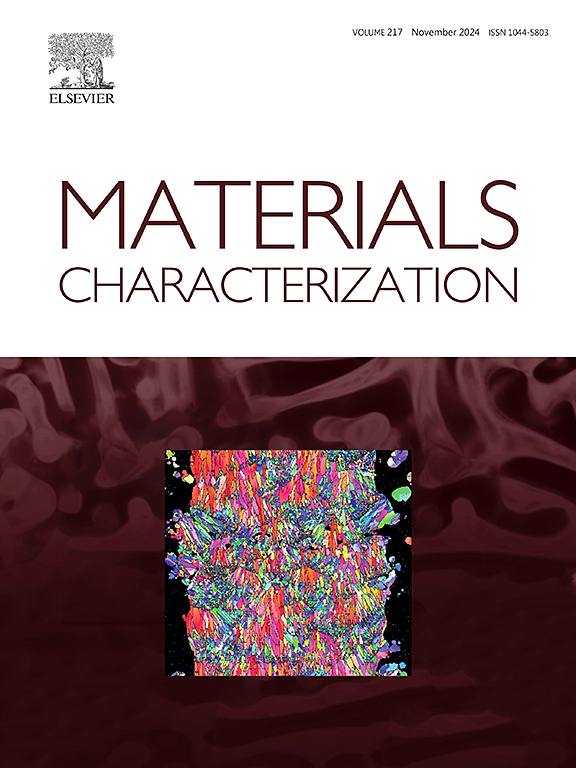Unveiling the crystallographic mechanism of molybdenum on enhancing hardenability in boron-containing steels
IF 4.8
2区 材料科学
Q1 MATERIALS SCIENCE, CHARACTERIZATION & TESTING
引用次数: 0
Abstract
This paper employs crystallographic quantification and visualization research methods to investigate the crystallographic mechanisms of the influence of molybdenum (Mo) content on the hardenability of boron-containing steels. Two steels with distinct Mo contents were designed to evaluate phase transformation kinetics and resultant hardness via Rockwell hardness measurements. Results demonstrate that the crystallographic mechanism on enhancing hardenability of elevated Mo contents is by fostering the preferential formation of high-angle grain boundaries (HAGBs) between specific crystallographic variants (V1/V6, V1/V9&19, V1/V12&20, V1/V15&23, V1/V17, V1/V18&22). To assess the transmission ability for a dislocation to pass through a grain boundary (GB), a slip transmission factor (N) is introduced. The inter-variant boundaries of V1/V6, V1/V9&19, V1/V12&20, V1/V15&23, V1/V17, and V1/V18&22 exhibit exceptional resistance due to their low slip transmission factors and large misorientation angles to slip transfer at GBs, directly amplifying macroscopic hardness through dislocation obstruction mechanisms. While V1/V2 and V1/V7 pairs dominate in boundary density across both steels, their negligible contribution to hardness arises from inherently low slip resistance (twelve slip systems for V1/V2 pair and six for V1/V7 pair share identical slip transmission factors close to 1.0 and common misorientation angles), highlighting the critical role of interfacial barrier efficacy over boundary abundance. Notably, the hardening effect correlates nonlinearly with HAGB density due to the heterogeneous slip-inhibiting capabilities of distinct boundary types. Furthermore, the crystallographic origin of variant pairs—whether derived from the same CP group or not—proves irrelevant to hardness enhancement, underscoring the primacy of boundary misorientation characteristics in governing strain accommodation behavior.
揭示钼提高含硼钢淬透性的结晶机理
本文采用晶体定量和可视化研究方法,研究了钼含量对含硼钢淬透性影响的晶体学机制。设计了两种Mo含量不同的钢,通过洛氏硬度测量来评估相变动力学和合成硬度。结果表明,Mo含量升高时,提高淬透性的晶体机制是促进特定晶体变体(V1/V6、V1/V9&19、V1/V12&20、V1/V15&23、V1/V17、V1/V18&22)之间优先形成高角度晶界(HAGBs)。为了评估位错通过晶界的传递能力(GB),引入了滑移传递系数(N)。V1/V6、V1/V9&19、V1/V12&20、V1/V15&;23、V1/V17和V1/V18&;22的变异体边界由于其低滑移传递因子和较大的滑移传递错取向角而表现出优异的阻力,通过位错阻挡机制直接放大宏观硬度。虽然V1/V2和V1/V7对在两种钢的边界密度中占主导地位,但它们对硬度的贡献可以忽略,因为它们固有的低防滑性(V1/V2对的12个滑移系统和V1/V7对的6个滑移系统具有接近1.0的相同滑移传递因子和共同的错取向角),突出了界面屏障效能对边界丰度的关键作用。值得注意的是,由于不同边界类型的非均匀阻滑能力,硬化效应与HAGB密度呈非线性相关。此外,无论是否来自同一CP群,不同对的晶体起源与硬度增强无关,强调了边界取向错误特征在控制应变调节行为中的首要作用。
本文章由计算机程序翻译,如有差异,请以英文原文为准。
求助全文
约1分钟内获得全文
求助全文
来源期刊

Materials Characterization
工程技术-材料科学:表征与测试
CiteScore
7.60
自引率
8.50%
发文量
746
审稿时长
36 days
期刊介绍:
Materials Characterization features original articles and state-of-the-art reviews on theoretical and practical aspects of the structure and behaviour of materials.
The Journal focuses on all characterization techniques, including all forms of microscopy (light, electron, acoustic, etc.,) and analysis (especially microanalysis and surface analytical techniques). Developments in both this wide range of techniques and their application to the quantification of the microstructure of materials are essential facets of the Journal.
The Journal provides the Materials Scientist/Engineer with up-to-date information on many types of materials with an underlying theme of explaining the behavior of materials using novel approaches. Materials covered by the journal include:
Metals & Alloys
Ceramics
Nanomaterials
Biomedical materials
Optical materials
Composites
Natural Materials.
 求助内容:
求助内容: 应助结果提醒方式:
应助结果提醒方式:


